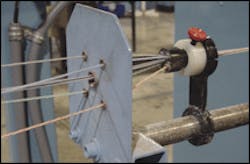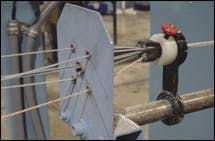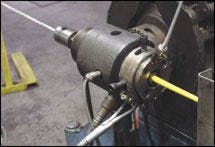The basics of manufacturing UTP cables
Knowing what goes into making a cable can help you understand the performance that comes out of it.
Today's network applications are more demanding than ever on the media over which they operate. The same twisted-pair technology that was used decades ago to support "plain-old-telephone" applications is now specified to support up to 250 MHz of information bandwidth. Obviously, times have changed and the cable manufacturing technology has kept pace.
Category 6 twisted-pair copper cables have the same look and feel as their primitive predecessors. What has changed to allow them to now offer such phenomenal bandwidth and electrical performance? The answer lies in the raw materials, handling, and construction of today's cables.
Successful unshielded twisted-pair (UTP) cable manufacturing relies upon the careful selection of copper conductors and thermoplastic compounds, and the meticulous process control of all principal manufacturing operations. These operations include producing an insulated primary conductor, transforming two primary conductors into a twisted pair, cabling the twisted pairs, jacketing the cable core, and packaging the finished product. Conscientious design and stringent process control are mandatory during each phase of manufacturing to ensure a properly performing finished product. The final assurance of a quality cable rests with the installer, and the care with which he or she preserves the mechanical integrity of the cable during installation.
Primary conductor design
A primary conductor used in the manufacture of a twisted pair consists of a 22- to 24-AWG solid copper conductor surrounded by an insulating material. Although seemingly simple in nature, every feature of the primary conductor must be carefully controlled to ensure proper electrical and mechanical performance. Key features include the profile of the copper conductor, the contour and smoothness of the copper conductor surface, and the concentricity of the conductor within the insulating material.
Measured insertion loss (often called attenuation), impedance, and return loss are directly related to the structure of the primary conductors. Insertion loss represents signal loss over distance. Therefore, larger diameter copper conductors, appropriate annealing of the copper conductors, and fewer pair twists per inch are all strategies to minimize signal loss. Physical geometry, such as the diameter and shape of the copper conductor, in addition to the dielectric properties, dissipation factor, and thickness of the primary insulation material, impact impedance and return loss performance. Surface defects, roughness along the copper conductor, an oval profile, flat spots, or variances in overall diameter all result in impedance discontinuities and contribute to signal reflections.
The central position and round profile, or eccentricity, of the conductor within the extruded insulation also impacts return loss performance. Extra care must always be taken to protect the bare copper conductors from damage and contamination prior to extrusion of the primary insulation.
Typical primary conductor manufacturing runs on a tandem insulating extrusion line. The advantages of such a setup include faster line speed and total automation, which precludes the introduction of damage to the conductor due to handling.
The drawing process
The first step in the tandem insulating extrusion process is to draw a larger gage (typically 12 or 13 AWG) hard copper wire through successive sets of high-quality diamond dies (typically 10), to a final copper wire size of 22 to 24 AWG. One drawblock or pulley pulls the wire through each die. As the copper is drawn and gage size is reduced, the line speed of successive drawblocks increases incrementally. Since the byproduct of the drawing process is extreme heat, the drawing equipment is continuously cooled and lubricated to ensure long die life, minimum slippage, and a smooth copper conductor surface. The finished copper conductor is pulled from the drawing equipment by a capstan and then annealed.
The drawing process work-hardens the conductor, leaving it susceptible to brittleness and cracking. Annealing equipment quickly raises the bare copper temperature to 450°F in a controlled nitrogen atmosphere to induce the appropriate metal softness needed to achieve desired elongation properties. Annealing makes the conductor workable and improves transmission performance, including, specifically, insertion loss.
Primary insulation extrusion follows the annealing process. The material used for the insulation is determined by the c(UL) flame rating (plenum CMP/FT6 or riser CMR/FT4), and category of transmission performance. Insulating materials are selected to be flexible and abrasion-resistant, as well as to exhibit low capacitance, low dielectric loss, high insulation resistance, and high voltage withstand. Varying degrees of flame-retardant performance are achieved through incorporating self-extinguishing materials such as chlorine, non-flammable materials such as fluorine, and inert materials such as clay into the insulation compound.
There are many factors to consider when selecting primary conductor insulation materials for different categories of cables. In particular, extrusion line speed and electrical performance can have a significant impact on the final cost and performance of UTP cables. For example, both LSPVC and FEP support plenum fire ratings. LSPVC primary insulation is extruded at a relatively low temperature of 350°F and at a line speed of up to 7,000 feet/minute. Unfortunately, the electrical properties of LSPVC compounds do not support the rigorous Category 5e and 6 transmission requirements.
FEP compounds do support data-grade electrical performance, however, they are extremely difficult to process due to the need for specialized high-temperature extrusion equipment and the unique melt-flow characteristics inherent to fluorocarbon insulations. FEP primary insulation extrusion runs at much slower line speeds of 2,000 feet/minute. Due to their material properties, riser-rated primary insulation compounds can be extruded at low temperatures at line speeds of up to 7,000 feet/minute for all categories of cable. Slower process line-speeds and premium raw materials are the principal reasons why plenum-rated cables cost significantly more than riser-rated cables.
Applying insulation
The insulation extrusion process consists of melting, homogenizing, and compressing (to release air bubbles) small, colorized thermoplastic pellets through an extruder head. The extruder feeds a crosshead, which is fitted with a wire guide (tip) and die. In this process, the insulation is applied over a preheated bare copper conductor.
Preheating the copper prior to extrusion ensures good insulation adhesion to the bare copper conductor, and is necessary to ensure the proper physical properties (tensile strength and elongation) of the insulation material. It is interesting to note that the line speed throughout the tandem insulating extrusion process is kept constant. Variables such as insulation thickness and surface condition are controlled by adjusting the amount of material fed through the extruder head, the temperature of the molten plastic, and the pressure under which it is extruded.
As insulating extrusion line speeds increase, it becomes critical to recognize the need for sufficient gradient cooling time and to provide a more controlled cooling operation. The temperature of the insulated primary conductor leaving the extrusion crosshead can be anywhere between 300°F and 800°F. Controlled cooling of the conductor ensures proper adhesion of the insulation and prepares the primary conductor for non-contact testing and handling. Techniques to cool the primary conductor include re-circulating water troughs and/or a water-spray bath.
Dual capstans that are spray-cooled with water pull the primary conductor through the cooling trough. The capstan configuration is critical, as it is the speed-controlling device for the entire tandem insulation extrusion line. Synchronization between the water-cooled capstans and the capstan that pulls the wire through the drawing assembly ensures smooth control of tension throughout the manufacturing process. Closed-loop feedback between and to each capstan ensures synchronization of process speed. Careful monitoring of the feedback ensures that there will be no backlash anywhere in the line, which would cause "chatter" or even result in abrasions on the primary insulation.
Sophisticated non-contract electronic equipment continuously monitors the electrical and mechanical properties of the primary conductor throughout all phases of production in the insulation extrusion line. For example, at critical locations on the line, monitoring devices provide the following information: conductor diameter, conductor temperature, wire line tension between the annealer and capstan, and wire line tension between the capstan and the take-up reel. In addition to diameter, the optical diameter gage also monitors for lumps, "neckdowns" (sudden changes in overall diameter), and other physical defects in or on the insulation. Additional gages monitor concentricity, eccentricity, and capacitance. An internal algorithm performs a Fast Fourier Transform (FFT) on measured insulation diameter and capacitance to further allow in-line monitoring of impedance performance.
A dielectric withstand test, which consists of an electrified ball-chain curtain through which the insulated conductor passes, is used to confirm insulation integrity. The ball-chain curtain is charged to a high voltage, typically 2.5 kV DC, and flaws in the insulation that reveal defective dielectric or bare copper cause a discharge to be detected.
The process controller records the precise location of any defects detected by the in-line monitoring equipment. This allows for easy identification, removal, and analysis prior to subsequent manufacturing operations.
The finished insulated primary conductor passes through an accumulator that maintains consistent wire tension as the product is spooled onto a take-up reel in lengths of up to 15,000 feet. Accumulators play an important role in that they maintain constant wire-line tension throughout the manufacturing process, including reel changes, to facilitate non-stop production.
Telecommunications cables use twisted-pair construction to deliver superior transmission performance and electromagnetic compatibility (low radiated emissions and high signal immunity), as well as to support a strong and flexible product design. Twisted-pair cables are successful at rejecting noise interference (crosstalk) because their pair geometry supports differential signal transmission schemes. This means that the transmitted signal that appears across the two conductors (the tip conductor and the ring conductor) of a twisted pair is equal in voltage magnitude, but opposite in phase.
Because of the twisted-pair geometry, noise that is coupled onto the two conductors from an outside source (either an adjacent pair or from the cabling environment) appears equal in voltage magnitude and equal in phase. Equipment receivers, engineered to detect the signal difference between the two conductors, see induced noise as two "like" voltages, which are simply subtracted out during the signal reconstruction process. By design, each pair in a four-pair UTP cable has a unique pair-twist rate, or "lay," to ensure crosstalk immunity from both outside sources and adjacent pairs.
Twisted-pair design
During the manufacturing process, particular attention is focused on maintaining uniform tension and the exact lay of the twisted pair. Twist lays for Category 6 cables are tighter and more stringently controlled than those specified for Category 5e and Category 3 cables. As a result, more precise and sophisticated twining equipment and slower process speeds are necessary to manufacture higher-performing UTP cables.
Manufacturing data-grade twisted pairs requires the use of pre-twisting equipment to prepare the conductor for the twining operation. Pre-twist machinery employs rotating bows that add torsion to each conductor prior to twining. This torsion induces the primary conductors to self-wrap during the twining process. This mechanical enhancement better controls conductor center-to-center distance within the twisted pair, allowing for improved return loss and impedance performance.
Twining equipment must apply equal tension to each primary conductor to ensure a balanced pair geometry. Data-grade primary conductors are twisted using double-twist twining technology. In this design, two bows rotate around a take-up reel. The conductors are fed through a lay plate into the bow spindles. As the conductors travel along the bow path, they pass over two deviation pulleys. Each pulley introduces one twist into the pair, hence the machine's name of "double-twist twiner." The advantages of this method are increased manufacturing throughput and twist lay accuracy.
Double-twist gang-twiners employed for Category 5e cable manufacturing simultaneously twist four pairs, each with its own pair lay. A main drive capstan pulls the product from the payoff reels through twining bows rotating at a set rate (which is fixed through appropriate driveline components) that controls each of the four unique pair lays. The four pairs are cabled together as they are spooled onto a rotating take-up reel. Line speeds associated with this process are typically 300 feet/minute for Category 3 cable and 100 feet/minute for Category 5e cable cores.
Category 6 twist technology requires the most precise line-drive controls available. Examples include servomotor controllers and AC vector drives that continuously monitor and maintain line speed. A precision double-twist twiner pre-twists each conductor and twists the pair in tandem, thereby offering infinitely adjustable pair-lay configurations. Optimized bow design minimizes performance degradation due to drag (windage) and/or tension on the pair. This process runs at a rate of up to 5,000 twists/minute and is the preferred method of pair manufacturing for Category 6 cables.
Four twisted pairs are cabled together prior to final jacketing. In the cabling process, the twisted pairs and any filler materials, such as star-separators, are pulled through a lay plate and die, and cabled together. The cabling process adds flexibility and strength to the cable assembly, and serves to restrict pair movement and separation after jacketing.
Jacketing and packaging
Jacketing a cable core primarily protects the finished product from handling damage and disturbance to the pair geometry. An optional ripcord may be incorporated over the cable core during the jacketing process. Jacket-compound selection affects the flame performance of the final assembly; LSPVC compounds are used for plenum-rated cables and PVC compounds are used for riser-rated cables.
During the re-spool operation, ink-jet printers apply a print legend to the jacket. These markings typically include reverse sequential-footage, date of manufacture, and lot traceability identifiers. At the re-spool operation, the cable is cut from master-reels of up to 100,000 feet into final-package lengths that are typically 1,000 feet.
Packaging options include plastic or wooden reels and "reel-less" boxes (commonly referred to by the brand name Reelex). Reel-less packaging requires special machinery to configure the finished cable into a self-supporting figure-8 form that allows tangle-free payout from a cardboard box fitted with a payout cone. Another option is to insert the reel into a holder and spindle assembly that is integral to a payout box (reel-in-a-box).
Protecting your investment
To maintain the integrity and performance of UTP cables, installers should take care not to disturb or damage the cable conductors or pair geometry. In particular, the following guidelines are recommended to maintain optimum performance:
- Remember that the exceptional transmission performance of UTP cables is due to the precise pair-lay construction. A maximum pair untwist of 1 inch is recommended for Category 3 connector terminations, and a maximum untwist of 0.5 inches is recommended for Category 5e and Category 6 connector terminations. Avoid excessive and/or unnecessary pair untwist.
- Respect proper pulling tension when installing four-pair UTP cables. TIA standards specify a maximum pulling tension of 25 foot-pounds.
- Maintain proper bend radius when pulling and dressing cables. TIA standards mandate a minimum bend radius of four times the cable diameter for four-pair UTP cables.
- Visually inspect cables for kinks, bends, snags, and crushed jackets during installation.
- Allow cables to have their space. Over-cinched tie-wraps, overstuffed cable trays, and overfilled J-hooks result in cable damage and degraded performance.
Twisted-pair cables have become the foundation of building telecommunications and data transmission today because of their design simplicity, ease of use, and robust performance. Advances in today's manufacturing techniques, coupled with conscientious installation practices, will help to ensure that the simple and economical twisted-pair stays at the forefront of telecommunications technology.
Valerie Rybinski is engineering services manager with Hitachi Cable Manchester Inc. (www.hcm.hitachi.com). She holds a BSEE degree and has worked in the telecommunications industry for more than a decade.




